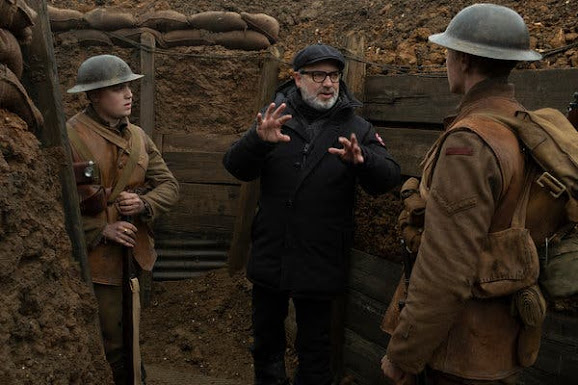Nominated For: Best Picture, Best Director; Sam Mendes, Best Original Screenplay, Best Cinematography, Best Makeup and Hairstyling, Best Production Design, Best Visual Effects, Best Sound Editing, Best Sound Mixing, and Best Original Score.
Won: Best Cinematography, Best Visual Effects, and Best Sound Mixing.
Runtime: 118 minutes
MPAA Rating: R (for violence, some disturbing images, and language)
Who should see it? Adults who are interested in war movies or technical filmmaking.Inspired by stories from Sam Mendes' grandfather who fought in World War I, 1917 is directed by Sam Mendes, who also co-wrote the screenplay alongside Krysty Wilson-Cairns. The film's defining feature is that it was shot and edited to resemble a single continuous take from start-to-finish. The one-take approach has been implemented before (most famously in Birdman), but never quite like this. Though the technique may seem like a cheap gimmick, what Sam Mendes and his crew have accomplished is nothing short of incredible and unlike any war film I've ever seen. As Christopher Nolan did in Dunkirk, Mendes seems keen on ushering in a fresh perspective on the war genre.Now, I feel it's important to note that this film isn't literally filmed in one-take. There are some hidden edits along the way, just as there were in Birdman, and one clear cut that's remarkably effective. That said, renowned cinematographer Roger Deakins and Nolan's frequent editor Lee Smith found some very creative ways to maintain the illusion that everything was filmed in one go. Even though I recognized the filmmaker's cheats around shooting an actual one-take, I couldn't help but be awestruck by the craftsmanship on display. Every technical aspect of this production is incorporated to the fullest, culminating into an experience that's explosive, immersive, and intimate. Maneuvering the camera through such a long stretch of land as it's forced to follow the subject every step of the journey is plenty impressive. But as I considered the nitty-gritty contributions required to pull that off, my appreciation grew substantially.An element of 1917 that's being somewhat overlooked is the production design. Due to the nature of the one-take, the filmmakers can't cheat by hiding incomplete pieces of the set. Everything is on display. Visual effects were likely used to extend portions of the set. Still, practically an entire battlefield had to be constructed with careful consideration for blocking actors and guiding the camera to pull this off. The claustrophobic and chaotic conditions of the trenches make this feat all the more outstanding. Considering George MacKay and Dean-Charles Chapman sustain performances for such lengthy periods, their work may not garner the attention it deserves either. The supporting cast is excellent as well, but none of them face the same challenge to the rigorous extent that MacKay or Chapman does.
Additionally, there's the matter of lighting. Roger Deakins had to factor every inch of the set into his layout. Though Deakins has the advantage of select edits, there are still lengthy sequences filmed in a single take with specific lighting demands for the entire duration. Whereas Birdman was mostly confined to a theater and the streets of New York, Deakins is forced to reckon with a sprawling tapestry that's ever-changing. To no one's surprise, Roger Deakins rises to the task and meets the impossible demands, cementing himself as one of the greatest living cinematographers. And I can't conclude this review in good conscience without applauding the versatile score composed by Thomas Newman. Newman's music ranges from bombastic to ethereal, underscoring the frenzied state of war and the serene moments whenever soldiers Lance Corporal Schofield and Lance Corporal Blake can catch a breath in their hurried quest.
If it weren't already clear, director Sam Mendes manages the ambitious production without a single misstep. A few plot conveniences aside, I fail to think of a single issue that plagued me after sitting on my thoughts for nearly a month. Everything works. I hesitate to call it a masterpiece, but Sam Mendes' one-take First World War epic is undoubtedly a stunning, cinematic tour de force! Above all, it serves as a stark reminder that filmmaking is a coordinated effort. And when everything comes together this nicely, something extraordinary is born that'll inspire generations to come.











0 Yorumlar